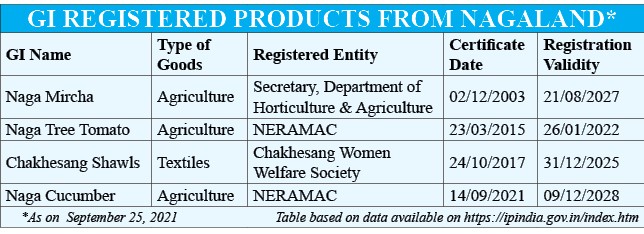
Moa Jamir
Dimapur | September 26
Naga Cucumber recently became the third agricultural products and fourth overall to be granted the GI tag from Nagaland.
It was officially certified by the India’s Registrar of Geographical Indications (GI) on September 14 as an agricultural good unique to Nagaland.
GI tag are defined as that “aspect of industrial property which refer to the geographical indication referring to a country or to a place situated therein as being the country or place of origin of that product,” according to the Intellectual Property India’s portal under the Office of the Controller General of Patents, Designs & Trade Marks (CGPDTM), India.
As per official certification documents, the present application for Naga Cucumber GI registration was first filed by the Guwahati-based North Eastern Regional Agricultural Marketing Corporation Ltd (NERAMAC) on December 10, 2018.
After long process, it was certified with the GI tag on September 14, with registration validity upto December 9, 2028.
“It’s indeed a proud moment for Nagaland that Naga Sweet Cucumber has bn granted GI tag. 2 othr crops hve earlier rcvd GI tag viz, Tree tomato & Naga King Chilly. GI certification will take our indigenous crops to global scale n boost farmer’s income,” (sic) tweeted Mhathung Yanthan, Advisor, Department of Horticulture and Border Affairs, Nagaland on September 23.
In the initial ‘Statement of the Case’, the NERAMAC informed that the corporation has been “assigned the responsibility of registration and supervision of GI by North East Council, Ministry of Development of North Eastern Region (DoNER) in consultation with the Directorate of Horticulture, Government of Nagaland.
Why Naga cucumber?
After the final process of application, the GI office in its’ public notice’ based on the NERAMAC application stated that cucumber has been traditionally cultivated by Naga farmers in their Jhum fields as a mixed crop mainly during the Kharif season (April –May).
“However, now the ‘off-season’ cucumbers from different districts of the Nagaland especially from Mokokchung district have gained much popularity within the state and now it has become a trend amongst the farmers in the district.”
Naga cucumbers are a kind of fruits that differ in taste, shape and sizes from those available in other parts of India.
Naga cucumbers are normally 15 to 20cm in length and 14-16 cm in diameter. On an average 5-8 numbers of cucumber weigh one kg, it added.
Regarding historical records, it noted that in Nagaland, cucumbers are being growing by the tribal people from “time immemorial.” Nagaland’s rank as 5th in area and 3rd in production of cucumbers in the North East was also stated as another reason behind its significance.
In the ‘Statement of the Case,’ it was further stated that a wide variety of local cultivars exist in Nagaland and these are grown in different parts of the state by different Naga tribes.
Cucumber is one of the most awaited fruit for Konyak people every year. It is called Maikoh” which literally means “give (Koh) to beloved (mai)”, it said, citing a story attached to its origin.
A group of young man from Morung (man’s dormitory) went to the jungle and discovered the fruit. They tasted it and found out that it was juicy and harmless so, they decided to take it back to their lovers. This gave birth to the name ‘Maikoh’ ever after,” it stated.
Mon, Mokokchung, Peren and Wokha districts are cited as some prominent area of cultivating Naga cucumber.
Uniqueness
As per the application, uniqueness of Naga cucumber is that they differ in taste, shape and sizes from those available in other parts of India.
It is grown completely organically and are juicy, soft and sweet, it noted.
The fruits are available throughout the years, can be grown both in summer and winter and Naga cucumbers are low in calories but high in potassium and contain high level of water.
With such a high level of water content and the added bonus of naturally occurring nutrients and trace minerals, it could be great supplements to drinking water or even serve as an alternative to consuming sports drinks, it said.
Cucumber is one of the most alkaline foods and because of its triterpenes, it may work well to regulate diseases that involve the immune system, it added.
In addition, it noted that cucumber is mostly consumed raw as salad and Naga people traditionally, used cucumber for medicinal purpose for constipation and jaundice.
Safeguard of GI
Meanwhile, the public notice noted that the cultivation and quality of Naga cucumber will be monitored by internal watchdog mechanism in order to maintain the original physical and chemical characteristics as per GI registration.
The watchdog comprised of representatives from Farmers groups of Nagaland; Officers of the Agriculture Department and DRDA; Horticultural Development Officer of the District; Representative of NERAMAC.
This committee will also help regulate the use of GI for the welfare of local farming community and frame the terms and conditions to use the name of Naga Cucumber by any of the marketing agency, it noted.
The logo of Naga Cucumber will be used to create wide publicity and promote GI registered produce. Naga Cucumber geographical growing area of in will be identified and will be allotted an identification number to ensure traceability and quality, it added.
GI Registered Products from Nagaland
Four products from Nagaland so far has been granted GI registration. The first to get the tag was ‘Naga Mircha’ under the then Department of Agriculture and Horticulture on December 2, 2003. The next was ‘Naga Tree Tomato’ on March 23, 2015 NERAMAC. The next to get was Chakhesang Shawls under Chakhesang Women Welfare Society on October 24, 2017. The fourth is the Naga Cucumber (See table). Applications for Ao, Angami and Sumi Naga shawls were ‘abandoned’ as per the GI portal.






